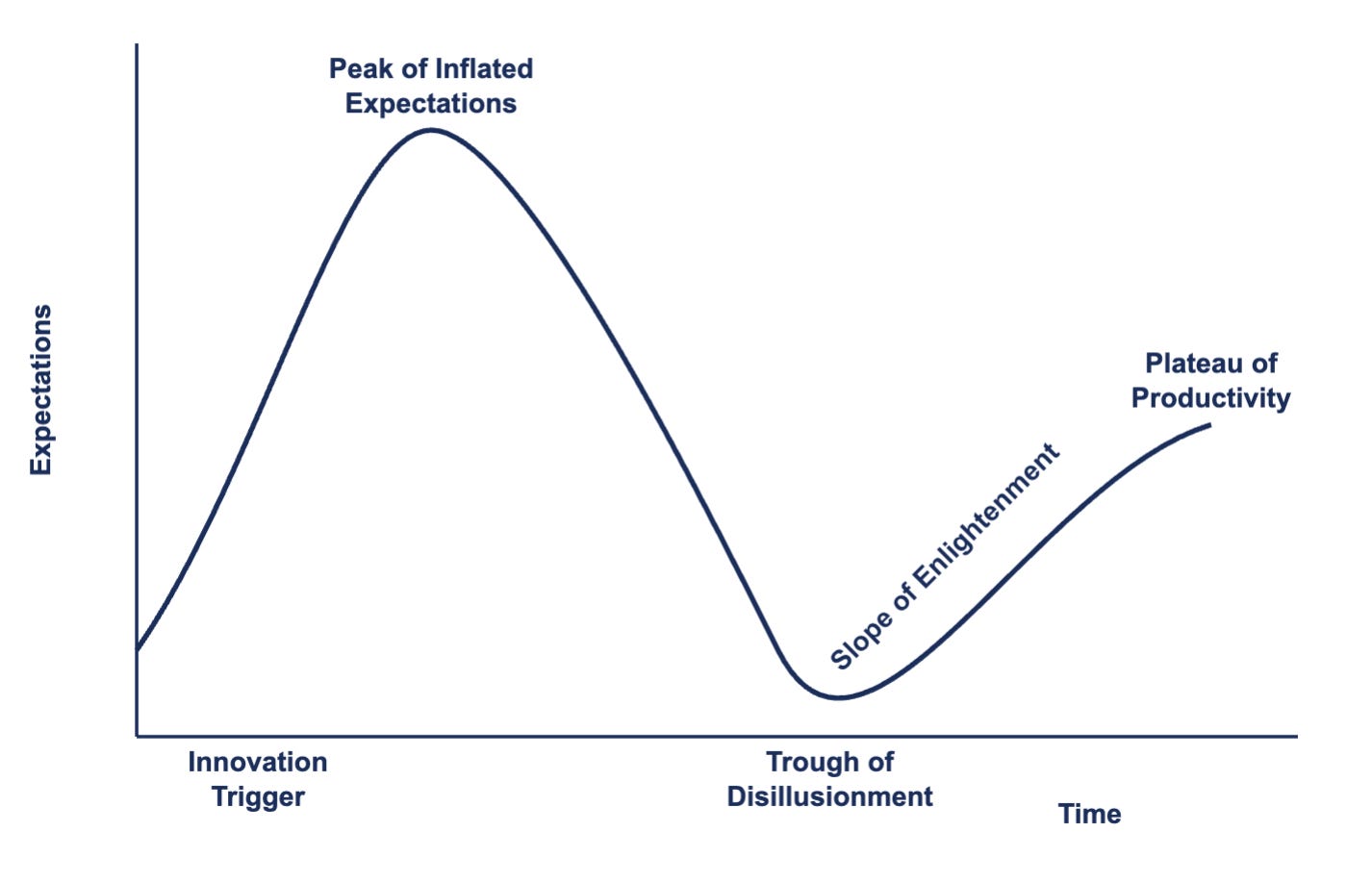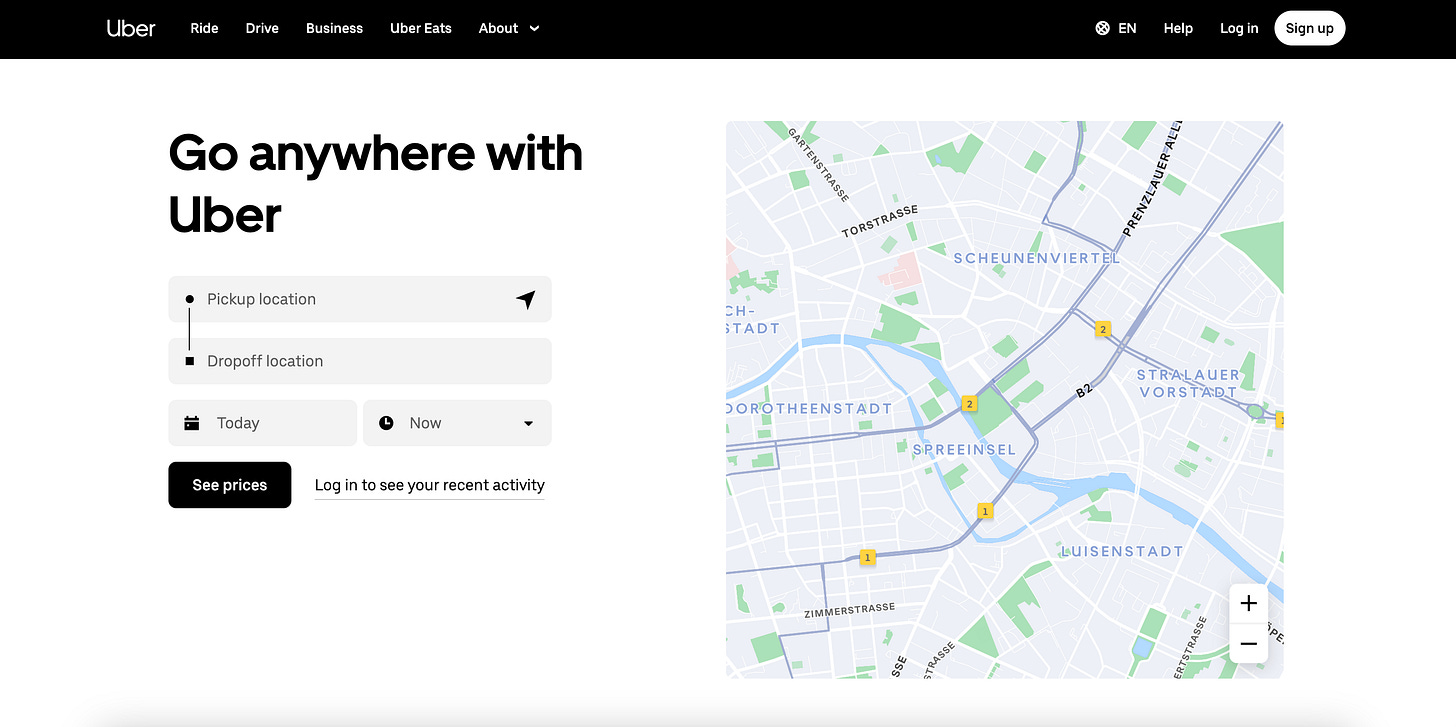AI for PM Productivity
A hands-on guide to leveraging AI across various areas of Product Management work
If we have to understand what's going on with all the noise around AI, which I believe is the most important technological advancement of our century, where we stand, and what's next, we have to zoom out and look at the Gartner hype cycle - a framework to understand the maturity of emerging technologies through five phases.
Over the last few years, we've experienced:
The initial phase of AI innovation trigger - where breakthrough capabilities in large language models and multimodal systems fundamentally reimagined what technology could accomplish.
Peak of Inflated Expectations - massive investment flowed in AI, with unrealistic implementation timelines and often disconnected strategic planning.
Trough of disillusionment - where, after significant publicity and media boom about AI, many companies discovered the gap between theoretical AI capabilities and operationalized value creation.
Slope of Enlightenment - here is where we stand in AI maturity in 2025. We have started seeing systematic approaches to AI implementation, together with some tangible success stories of AI delivering measurable value across organizations.
The biggest challenge organizations face in this phase is translating AI's transformative potential into a practical and repeatable implementation framework, while also building and upskilling their workforce for the AI literacy and expertise required in this new era. In addition to talent development, Product Teams face difficulties in determining where and how to embed AI capabilities into their existing product architectures and data ecosystems, and aligning their AI investments with quantifiable business outcomes.
This guide aims to focus on increasing AI fluency for product managers by providing them with a general framework, along with examples, a list of tools, and prompt templates that you can copy and use in four main areas of product work: Product Strategy, Product Discovery, Product Delivery, and Product Management Career Development. Let's dive in!
1. AI for Product Strategy
AI can serve as a partner to PMs throughout the entire product strategy development, acting as a critic, researcher, and "bar raiser," helping to shape a concrete and compelling product strategy.
How AI Enhances Product Strategy
Here are some key ways AI can support product managers in shaping a winning strategy:
Market & Competitive Intelligence: Generate comprehensive analyses of competitors, market trends, and differentiation opportunities
Strategy Refinement: Identify gaps, inconsistencies, and enhancement opportunities in your product strategy artifacts
Alignment Facilitation: Create communication artifacts that ensure strategic clarity across functions
Practical Examples
Let’s explore some practical examples of how AI can be applied:
Example 1: Conduct an Industry Analysis for Product Differentiation
Prompt:
Please conduct a thorough analysis to differentiate my product by addressing underserved customer pain points in creative and non-conventional ways.
CONTEXT:
- Industry/Market: [Industry]
- Target users: [User Sgementation/description]
- Key competitors: [Competitor 1], [Competitor 2], [Competitor 3]
- Current limitations: [Key gaps in market offerings]
PAIN POINTS:
- Underserved needs: [Specific pain points]
- Current workarounds: [How users solve today]
- Emotional impact: [Key frustrations]
DIFFERENTIATION STRATEGY:
- My potential unique advantage (MOAT): [Your MOAT, e.g., Exclusive partnerships with premium suppliers]
- Unconventional approaches to explore: [Areas for innovation, e.g., Gamification for user engagement]
- Resources or technologies we could leverage differently: [Unique resources/technologies, e.g., AR/VR for immersive UX]
EXPECTED OUTCOMES:
- Definition of success: [Expected outcome of differentiation e.g. increase conversion, User Retention, etc]
- Timeline considerations: [Short-term vs. long-term opportunities]
- Measurement approach: [How to validate success]
DELIVERABLES:
1. A prioritized list of the most promising differentiation opportunities
2. Creative, non-conventional approaches to address each opportunity
3. Implementation considerations and potential challenges
4. A framework for testing and validating these approaches with usersExample 2: Use AI to Spot Gaps and Elevate the Quality of Your Product Strategy Artifact
Prompt:
As a world-class Senior PM, critically review my Product Strategy document against high-quality standards:
<template> Product Strategy Framework (e.g., Amazon Working Backward) </template>
<strategy_document> Your document here </strategy_document>
<example> Example of a good strategy </example>
Provide:
1. Prioritized list of top 10 improvements (ranked by impact):
• Issue/opportunity (bold)
• Strategic importance
• Specific recommendation
2. Brief assessment of:
• Framework adherence
• Customer value articulation
• Cohesiveness
• Strategic alignment
Be brutally honest. Address both structural issues and strategic concerns.2. AI for Product Discovery
If there's one area where AI is already transforming product management, it's product discovery. AI can accelerate idea generation, uncover hidden user needs, and validate concepts—helping PMs make more informed decisions with less guesswork and much faster!
How to Use AI in Product Discovery
I’ve been consistently using AI for all types of product discovery work, including:
Brainstorming: You could leverage AI to generate multiple versions of your ideas or add a creative twist to them.
Opportunity Discovery: Analyzing unstructured customer data (feedback, research interviews, reviews) to uncover meaningful patterns and actionable insights quickly.
Rapid Validation: Building high-fidelity prototypes without coding and testing them with users to validate concepts before committing engineering/design resources.
Practical Examples
Let’s explore some practical ways AI can be applied in product discovery:
Example 1: Opportunity Discovery through Analyzing Customer Feedback
Prompt:
I'm a Senior Product Manager for [Product]. I need to identify the top 5 customer feature requests from our recent feedback.
Using the attached CSV of Customer reviews:
1. Analyze and categorize common pain points and feature requests
2. Rank them by frequency and sentiment intensity
3. Identify relationships between different requests
4. Present findings as a bar chart visualization with frequency counts
5. For each top request, provide 1-2 representative customer quotes
Optional: Note any emerging trends or unexpected patterns in the feedback.Example 2: Going from a Raw Idea to a Working Prototype in Less Than an Hour
Imagine you are a PM for Uber's Search Page. Your goal is to build a prototype to test a new feature called the Multi-Destination Planner on the Search page.
Here’s how the Uber Search Page currently looks.
Take a screenshot of this page, go to V0.dev - an AI prototyping tool, upload the screenshot, and use this prompt: “Build a fully functional prototype in [Programming Language, e.g., React] to match this design. Match it exactly!”
You want to add a new UI element between the Pickup Location and the Dropoff Location that enables users to add multiple stops in one ride. Add a Plus (+) button next to the Dropoff Location, allowing users to add an extra stop. Update the text to reflect the first stop, using the same input box as the Dropoff location.
Here is our prototype with the changes we wanted to add:
This approach transforms what would traditionally require design or engineering resources. It enables PMs to quickly develop and validate multiple ideas, radically speeding up the learn-build-measure cycle for product teams!
3. AI for Product Delivery
AI can help product managers streamline execution, prioritize effectively, and mitigate risks early in the delivery process, delivering customer value sooner.
How AI Accelerates Product Delivery
Here are some ways AI can support seamless product delivery:
Creative Execution: AI can help you restructure roadmaps, break initiatives into manageable milestones, and suggest alternative ways to deliver value faster to your customers.
Prioritization Assistant: AI can help PMs prioritize effectively. It can also help you use your favorite prioritization framework (e.g., RICE) and focus on the highest-impact work first.
Proactive Risk Identification: AI can detect potential delivery blockers (e.g., downstream dependencies, resource constraints) early, helping product teams address risks before they escalate.
Practical Examples
Let's look at some practical examples:
Example 1: Use AI as a Critic for Your Execution Plan and Find Creative Execution Paths
My goal is to [initiative objective] within [deadline].
Given the following constraints [team size, dependencies, risks],
what are some alternative ways to break this initiative into manageable parts?
Here’s my current milestone breakdown for [initiative].
What are some unconventional ways to restructure this roadmap to
accelerate delivery while maintaining quality, given [constraints]?
If we had to achieve [initiative objective] in half the time,
how would you rethink the breakdown of work?Example 2: Use AI as Your Prioritization Assistant
Can you prioritize these tasks based on [Framework/criteria],
focusing on the most high-impact items first?
Provide clear reasoning and a step-by-step explanation for your prioritization decision, and ask for any additional information you would need from me to prioritize more confidently.4. Use AI for your Career Development
AI can transform how product managers approach their career development, serving as a personalized career coach that creates tailored development plans based on your specific context, feedback, and career aspirations.
How AI Assists You in Your Career Development
Here are some ways AI can support your career progression:
Personalized Skill Building: AI can analyze your current skills against your role expectations to identify development opportunities aligned with your career progression.
Feedback Integration: AI can help synthesize feedback from multiple sources (manager reviews, peer assessments, self-evaluations) to identify patterns and areas for improvement.
Personalized Career Planning: AI can help shape your long-term career aspirations, identifying specific career milestones, expectations, and the necessary accomplishments to reach your professional goals.
Practical Examples
Let's look at some practical applications together:
Example 1: Creating a Targeted Skill Development Plan
You’ve received feedback from your manager that you need to improve your strategic thinking. Here is how you can create your personalized learning path: Go to Perplexity, an AI-powered search engine with real-time internet data, and use this prompt: “I am a [product manager] focused on [domain]. Over the next three months, I want to improve my [strategic thinking]. What specific skills or behaviors will help me achieve this while making a tangible impact in my role? Include a list of top-notch resources (e.g., podcasts, videos, blog posts) that I can use to learn about these topics.”
Example 2: Craft a Personalized Career Development Plan
<expectation> Career expectations/framework for [Your role] at [Your company] </expectation>
<feedback> 360 feedback from your manager and stakeholders </feedback>
As a Senior PM at [company] aiming for promotion to [next role] within 1 year, analyze:
1. The specific gaps between current performance and [next role] expectations
2. Key themes from your 360 feedback (strengths to leverage, improvement areas)
Deliver:
1. A 6-month career progression roadmap with 3-5 concrete milestones
2. 3 specific, high-impact deliverables you could own that directly address promotion criteria
3. Actionable tactics to improve in your identified growth areas
Make recommendations highly specific to your situation, not generic career advice.To Wrap Up:
We are at a critical inflection point in AI innovation that demands both new strategic and tactical skills from product managers. The transformation of product management in the AI era isn’t merely about trying new AI tools—it requires a fundamental reimagining of how we shape, define, and ship products. By incorporating AI into your product and career development process, you not only significantly increase your productivity, effectiveness, and ultimately your impact, but also gain hands-on experience with AI, establishing practical foundations and frameworks for assessing AI opportunities and potential impact in your product domain. This practical experience prepares you for navigating what is undoubtedly the most significant technological innovation of our century—AI.
My AI took stack:
Claude: for code generation, data analysis, and writing
Perplexity: for curated real-time information search
Vercel V0: for UI Prototyping
ChatGPT: for creative work and brainstorming
If you find this guide helpful and are interested in learning more about the topic, I’m hosting a hands-on workshop where I’ll share more proven AI examples and case studies. Since this is the first cohort, I want to keep the session focused on a small group (only 15 people) to ensure significant value is delivered! RSVP here to be among the first to receive details and secure your spot before it fills up!
👋 Til next time!



